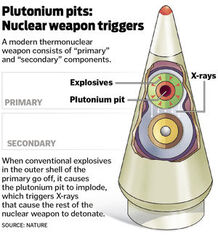 House Armed Services Strategic Forces Subcommittee mark-up is at 3:30 p.m. on June 4 — SRS pit production will NOT be authorized or funded by Congress
House Armed Services Strategic Forces Subcommittee mark-up is at 3:30 p.m. on June 4 — SRS pit production will NOT be authorized or funded by Congress
Mark-up language: “H.R. 2500—FY20 NATIONAL DEFENSE
AUTHORIZATION BILL SUBCOMMITTEE ON STRATEGIC FORCES”
page 10:
Section 31xx—Modification to Plutonium Pit Production Capacity
This section would repeal the requirement for the Secretary of Energy to demonstrate the capability to produce war reserve plutonium pits at a rate sufficient to produce 80 pits per year by 2027.
page 67:
SEC. 31ll.ø69752¿ MODIFICATION TO PLUTONIUM PIT
2 PRODUCTION CAPACITY.
3 (a) FINDING AND SENSE OF CONGRESS.–
4 (1) FINDING.—Congress finds that a recent
5 study by the Institute of Defense Analyses notes, ‘‘a
6 key milestone will be achieving the Plutonium
7 Sustainment Program goal of 30 pits per year at
8 Los Alamos National Laboratory’’.
9 (2) SENSE OF CONGRESS.—It is the sense of
10 Congress that the National Nuclear Security Admin11
istration should prioritize achieving production of 30
12 pits per year at Los Alamos National Laboratory
13 and ensure that efforts to design and construct a
14 second site do not divert resources, including per15
sonnel and funding, from Los Alamos National Lab16
oratory.
— and pages 94-95:
Excess Plutonium Disposition
The committee notes the United States’ commitment to dispose of 34 metric tons of excess plutonium as part of the Management and Disposition of Plutonium Agreement, signed in 2000, with Russia. The committee also notes that in October 2018, the Secretary of Energy delivered official notice of contract termination of the
Mixed-Oxide Fuel Fabrication Facility (MFFF) due to significant costs, delays and difficulties executing this program. The committee also emphasizes that the Secretary proposed to dispose of this material through the Dilute and Dispose program which was more affordable and required a fraction of the funding MOX would have required. The MFFF would have disposed of the 34 metric tons by creating mixed-oxide fuel for use in commercial power reactions. The committee
notes the commitment to dispose of the 34 metric tons of excess plutonium and is concerned that funding has not been prioritized to implement this program due to prioritizing plutonium pit production at the Savannah River Site, leading to questions about the U.S. nuclear nonproliferation commitment to disposal of this excess material.
Therefore, the committee directs the Administrator for Nuclear Security to submit a report to the congressional defense committees not later than February 28, 2020, with a detailed plan, including timelines, plans to engage the State of New Mexico and Russia on any necessary negotiations to pursue the Dilute and Dispose
approach, funding requirements, including funding requirements over the next 5 years, to begin disposing of this excess plutonium.
Mark-up posted here: